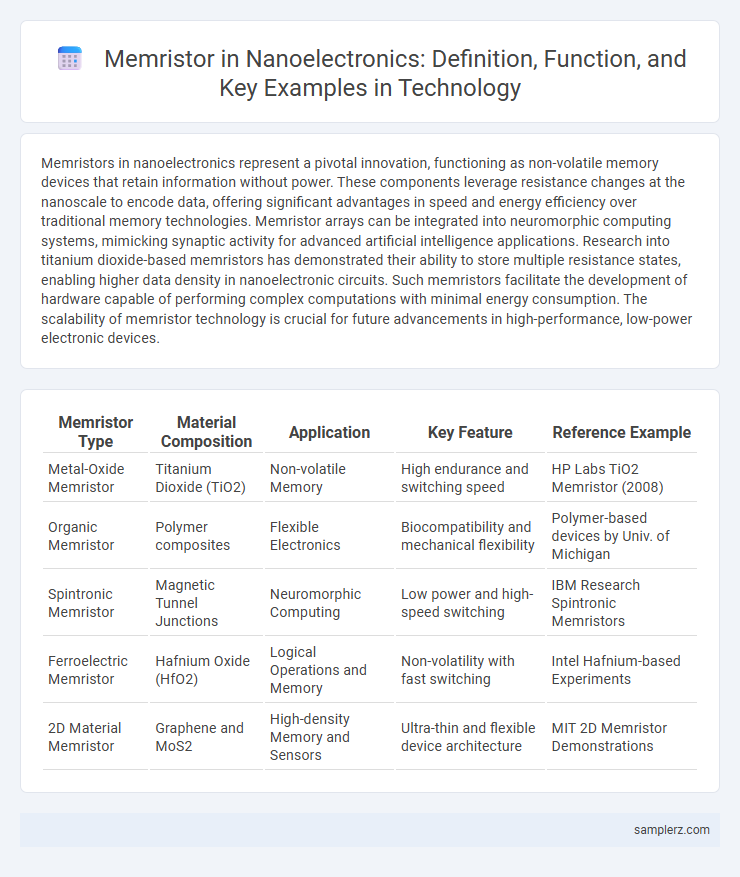Memristors in nanoelectronics represent a pivotal innovation, functioning as non-volatile memory devices that retain information without power. These components leverage resistance changes at the nanoscale to encode data, offering significant advantages in speed and energy efficiency over traditional memory technologies. Memristor arrays can be integrated into neuromorphic computing systems, mimicking synaptic activity for advanced artificial intelligence applications. Research into titanium dioxide-based memristors has demonstrated their ability to store multiple resistance states, enabling higher data density in nanoelectronic circuits. Such memristors facilitate the development of hardware capable of performing complex computations with minimal energy consumption. The scalability of memristor technology is crucial for future advancements in high-performance, low-power electronic devices.
Table of Comparison
| Memristor Type | Material Composition | Application | Key Feature | Reference Example |
|---|---|---|---|---|
| Metal-Oxide Memristor | Titanium Dioxide (TiO2) | Non-volatile Memory | High endurance and switching speed | HP Labs TiO2 Memristor (2008) |
| Organic Memristor | Polymer composites | Flexible Electronics | Biocompatibility and mechanical flexibility | Polymer-based devices by Univ. of Michigan |
| Spintronic Memristor | Magnetic Tunnel Junctions | Neuromorphic Computing | Low power and high-speed switching | IBM Research Spintronic Memristors |
| Ferroelectric Memristor | Hafnium Oxide (HfO2) | Logical Operations and Memory | Non-volatility with fast switching | Intel Hafnium-based Experiments |
| 2D Material Memristor | Graphene and MoS2 | High-density Memory and Sensors | Ultra-thin and flexible device architecture | MIT 2D Memristor Demonstrations |
Introduction to Memristors in Nanoelectronics
Memristors, as fundamental nanoelectronic components, exhibit unique resistance-switching behavior that enables non-volatile memory and logic applications. Their ability to retain resistance states without power supports advancements in neuromorphic computing and high-density data storage at the nanoscale. Integration of memristors in nanoelectronics offers unprecedented potential for energy-efficient circuits and scalable architectures in modern technology.
Fundamental Properties of Memristors
Memristors exhibit fundamental properties such as non-volatility, resistance switching, and analog memory capability, which make them essential components in nanoelectronics. Their ability to retain resistance states without power enables ultra-low power consumption and high-density data storage. These characteristics allow memristors to efficiently replicate synaptic functions in neuromorphic computing applications.
Types of Memristive Materials Used in Nanoelectronics
Memristors in nanoelectronics utilize various memristive materials, including metal oxides like titanium dioxide (TiO2) and hafnium oxide (HfO2), known for their reliable resistive switching properties. Organic materials such as polyaniline and graphene oxide offer flexibility and scalability in device fabrication. Emerging two-dimensional materials like molybdenum disulfide (MoS2) demonstrate promising memristive behavior suitable for next-generation nanoscale memory and neuromorphic computing applications.
Fabrication Techniques for Nanoscale Memristors
Fabrication techniques for nanoscale memristors often involve advanced methods such as atomic layer deposition (ALD) and electron beam lithography to achieve precise control over material thickness and device dimensions at the atomic scale. Atomic layer deposition enables uniform oxide layers essential for consistent resistive switching behavior in memristive devices. Electron beam lithography facilitates the patterning of nanoscale electrodes, crucial for enhancing device scalability and performance in nanoelectronic applications.
Example 1: Titanium Dioxide Memristors in Memory Storage
Titanium dioxide memristors are a prime example of nanoelectronic devices used in memory storage due to their ability to retain resistance states without power, enabling non-volatile memory applications. These memristors function by modulating oxygen vacancy migration within the titanium dioxide layer, effectively switching between high and low resistance states to store binary information. Their nanoscale size and low power consumption make them suitable for next-generation memory solutions like Resistive Random Access Memory (ReRAM).
Example 2: Organic Memristors for Flexible Electronics
Organic memristors in flexible electronics demonstrate significant potential for wearable devices due to their lightweight and bendable properties. These devices utilize conductive polymers and organic materials to achieve non-volatile memory with low power consumption. The integration of organic memristors enables advanced brain-inspired computing and adaptable sensor networks in nanoelectronic systems.
Example 3: Spintronic Memristors for Logic Circuits
Spintronic memristors leverage electron spin to store information, significantly enhancing the efficiency of logic circuits in nanoelectronics. These devices utilize magnetic tunnel junctions to achieve non-volatile memory with low power consumption and high switching speeds. Their integration in spintronic logic circuits enables advanced computing architectures with improved scalability and data retention.
Integration of Memristors in Neuromorphic Computing
Memristors are increasingly integrated into neuromorphic computing architectures for their ability to mimic synaptic functions with high efficiency and low power consumption. These nanoelectronic devices enable dense, scalable, and analog-like memory storage, crucial for replicating neural networks in hardware. Research demonstrates memristor arrays facilitating real-time learning and adaptive processing, significantly advancing brain-inspired computing systems.
Performance Comparison with Conventional Nanoelectronic Devices
Memristors exhibit superior energy efficiency and faster switching speeds compared to traditional nanoelectronic devices such as CMOS transistors, enabling enhanced performance in high-density memory applications. Their non-volatile resistance switching mechanism allows for lower power consumption and greater durability, making them ideal for neuromorphic computing systems. Studies reveal that memristors achieve higher scalability and improved integration density, significantly outperforming conventional silicon-based nanoelectronic components.
Future Trends and Applications of Memristors in Nanoelectronics
Memristors are poised to revolutionize nanoelectronics with their ability to enable ultra-dense memory storage and neuromorphic computing architectures. Emerging applications include energy-efficient artificial intelligence hardware and adaptive circuits that mimic synaptic functions, enhancing real-time data processing capabilities. Future trends emphasize scalability, integration with CMOS technology, and the development of flexible and wearable electronics leveraging memristor arrays.

example of memristor in nanoelectronics Infographic
 samplerz.com
samplerz.com